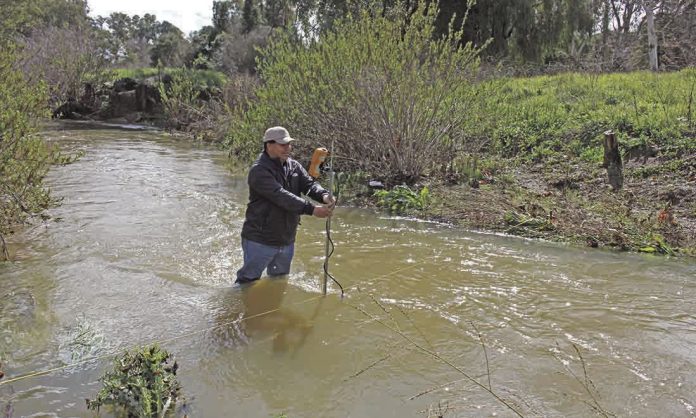The late-winter rain has been good news for gardeners, farmers and the steelhead.
The Santa Clara County Water District sent out teams of hydrographers to streams in the Pajaro River watershed early this month, and initial reports showed streams running at near seasonal levels.
One hydrographer at Uvas Creek in Gilroy reported stream flows nine times greater than the previous month. With the recent rains, things are looking up for naturalists, who were concerned that bone-dry January and February would blunt comebacks by several endangered species.
The 104-mile Uvas-Llagas watershed flows south, gathering rainwater from the broad valleys of southern Santa Clara County, and meets the Pajaro River in northern San Benito County.
The timing of this rain couldn’t have been better, according to Herman Garcia, who had been carefully monitoring endangered species in the watershed for two decades.
He waded into Uvas Creek in Gilroy in early March with a water district hydrographer, to get a first-hand look at the flowing water.
Garcia said the steelhead (Oncorhynchus mykiss) is set to begin the fish species’ spawning runs this month. For several years, drought conditions prevented that trek from Monterey Bay up streams like Uvas Creek to lay eggs. But the spawning runs returned in 2016 and 2017, after heavy winter rains.
Uvas Creek supports one of the last remaining wild runs of the steelhead, which is a federally threatened species that spawns in fresh water for up to two years. The young fish migrate to the ocean where they reach adulthood, and adults return to their natal streams to begin the process again.
Garcia said fields in northern San Benito County rely on shallow wells for irrigation, and that the deep aquifers that provide drinking water for much of the region are still in good shape.
More than 50 streams flow into Pajaro River, and they need late-winter maintenance, he said.
His 15-year-old nonprofit environmental organization, Coastal Habitat Education and Environmental Restoration, hosted a Uvas Creek cleanup on Saturday, March 10 at the Uvas Creek entrance to Christmas Hill Park in Gilroy.
The volunteers included high school students who pulled garbage and trash in the creek from Silva’s Crossing to the Santa Teresa Boulevard bridge.
The Santa Clara Valley Water District reported that as of March 13, its 10 reservoirs had a combined storage of just 29.4 percent of their full capacity.
Founded on donations in 2003, CHEER has negotiated conservation easements along the wide Pajaro River watershed, aiming at restoring habitats. It operates Coastal Watersheds Garbage Museum, a “Mobile Education Unit” that delivers interactive environmental education to local schools and community groups.
Steelhead trout are the same fish as the rainbow trout, but the latter spends its entire life in fresh water and the former live a major part of their lives in the Pacific. They look different as adults because of their different diets and environments.
Females can lay as many as 10,000 eggs in nests called redds, and, unlike salmon, which die after they spawn, both male and female steelhead return to the ocean and make annual spawning runs, sometimes more than once a year, during lifetimes that can last as many as a dozen or so years. They can grow to between 40 and 50 pounds.
In 2006, the Pajaro River was designated America’s most endangered river by the American Rivers organization, due to levees constructed by the Army Corps of Engineers along its lower 22 miles (35 km) and severe agricultural runoff into the river.
Native California fish present in the lower Pajaro River are: Inland Threespine Stickleback (Gasterosteus aculeatus microcephalus), Sacramento Perch (Archoplites interruptus), Riffle Sculpin (Cottus gulosus), Sacramento Tule Perch (Hysterocarpus traskii traskii), South Central California Coast Steelhead (Oncorhynchus mykiss), and Thicktail Chub (Siphatales crassicauda).








